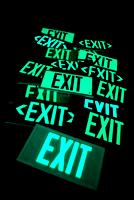Signage switch issues illuminated
 New laws will soon be in place to allow the use of glow-in-the-dark exit signs.
New laws will soon be in place to allow the use of glow-in-the-dark exit signs.
From the first of May, amendments to the National Construction Code of Australia will allow photoluminescent (PL) signs to be used instead of internally illuminated exit signs.
The move has raised concerns within the Lighting Council of Australia, which says that glowing signs are not nearly bright enough in dark or smoky situations, and that they require extra light sources anyway.
In its consideration of the changes last year, he Australian Building Codes Board (ABCB) said it saw clear advantages to the “innovative alternative” exit signs.
The ABCB said in a statement that photoluminescent (PL) signs offer; “Low installation and maintenance costs, little reliance on back-up electricity supply, a high level of redundancy and low ongoing running costs.”
But the chair of the peak body for Australia’s lighting industry, Russell Loane from Lighting Council Australia, says there are extra concerns and costs that the building body appears to have missed.
“One of the major concerns is the confusion amongst electricians, building owners and building managers, as to how PL exit signs may be used,” he said.
“If installed in accordance with the NCC amendment, PL [photoluminescent] signs will cost considerably more to install and maintain than the current electrically powered LED exit signs,” Mr Loane said.
“The installation of a PL exit sign typically requires the installation of two additional luminaires.
“Firstly, the NCC amendment requires that a PL exit sign must have a dedicated, uninterrupted light source continuously illuminating 100 lux onto the face of the sign. Secondly, the NCC already requires, via AS/NZS 2293.1, that an emergency luminaire must be installed within two metres of an exit door or typically where exit signs are located (AS2293-1 clause 5.4.1).”
He says that the light thrown off by an LED exit sign was more than enough to serve as its own emergency light.
In fact, according to the Lighting Council, glow-in-the-dark lights can manage only a fraction of the necessary luminance.
“Exit signs have over 30 years of test and empirical data supporting the worldwide view that the safety of an exit sign is determined by its luminance level, and that the appropriate luminance level to ensure safe egress in an evacuation scenario is between 8cd/m² (candela per square metre) and 15cd/m²,” Loane said.
“The amendment to the NCC provides for a luminance level for PL exit signs of 30mcd/m² (millicandela).
“One candela is 1000 times brighter than one millicandela,” he said.
That means a photoluminescent sign would only provide about 1/250th of the necessary brightness.
“When firefighters are in a smoke affected environment, the visibility of exit signs is an important safety aid, which will be compromised by the lower level of brightness of PL exit signs,” a submission from the Metropolitan Fire Brigade, Building Code and Audits Division reads.
“It will be difficult to evaluate the compliance of a PL sign during essential services audits, and Fire Brigade Fire Safety Inspections,” Loane said.
“It is not difficult to envisage situations where a much cheaper, stick on, glow in the dark exit sign will be used in a non-compliant way. Essential life safety devices should not be put in a situation where they can be compromised in this way.”








 Print
Print